Chambers Street–World Trade Center/Park Place (New York City Subway)
Chambers Street– World Trade Center/Park Place | |||||||||
|---|---|---|---|---|---|---|---|---|---|
|
| |||||||||
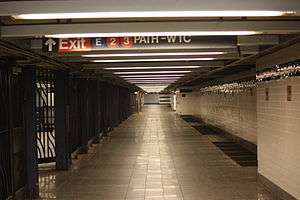 | |||||||||
| Station statistics | |||||||||
| Address |
Church Street between Chambers Street & Vesey Street New York, NY 10007 | ||||||||
| Borough | Manhattan | ||||||||
| Locale | Financial District, Tribeca, World Trade Center | ||||||||
| Coordinates | 40°42′46″N 74°00′35″W / 40.712655°N 74.009657°WCoordinates: 40°42′46″N 74°00′35″W / 40.712655°N 74.009657°W | ||||||||
| Division | A (IRT), B (IND) | ||||||||
| Line |
IND Eighth Avenue Line IRT Broadway–Seventh Avenue Line | ||||||||
| Services |
2 3 A C E | ||||||||
| System transfers |
At Cortlandt Street: N R W | ||||||||
| Transit connections |
| ||||||||
| Structure | Underground | ||||||||
| Levels | 2 | ||||||||
| Other information | |||||||||
| Station code | 624[1] | ||||||||
| Wireless service |
| ||||||||
| Traffic | |||||||||
| Passengers (2017) |
14,825,863 (station complex)[3] | ||||||||
| Rank | 17 out of 425 | ||||||||
| |||||||||
| |||||||||
| |||||||||
Chambers Street–World Trade Center/Park Place is a New York City Subway station complex on the IND Eighth Avenue Line and IRT Broadway–Seventh Avenue Line. Located on Church Street between Chambers and Vesey Streets in Lower Manhattan, it is served by the:
The station also connects to the BMT Broadway Line at Cortlandt Street, served by the N, R, and W trains, via a passageway within fare control at the south end of the IND Eighth Avenue Line's local platform. There are also connections to the PATH via the World Trade Center Transportation Hub. These connections link this station with the nearby Fulton Center, via the out-of-fare-control Dey Street Passageway.
Station layout
| G | Street level | Exit/entrance | |
| B1 | Mezzanine | Fare control, station agent
| |
| B2 | WTC Passageway | To | |
| Northbound local | ← | ||
| Island platform, doors will open on the left or right | |||
| Northbound local | ← | ||
| Northbound express | ← |
||
| Island platform, doors will open on the left | |||
| Southbound express | | ||
| B3 | Northbound | ← ← | |
| Island platform, doors will open on the left | |||
| Southbound | | ||
IND Eighth Avenue Line platforms
Chambers Street–World Trade Center on the IND Eighth Avenue Line is an express station with four tracks and two island platforms, but in an unusual layout: the station has separate island platforms for express and local trains.[4] Both island platforms can accommodate 600-foot (180 m) trains. There is a passenger connection between the two platforms at mezzanine level. This passageway also includes the in-system transfer to the IRT station. Both platforms opened just after midnight on September 10, 1932, as did the rest of the IND Eighth Avenue Line north to Inwood–207th Street.[5][6]
A late-1990s renovation saw prefabricated tile panels installed on the trackside wall of the express platform, with a tile band of Concord Violet bordered in black and "CHAMBERS" in white Copperplate lettering on black tiles on each panel, and on the local platform's walls the new tiles were installed in 3-foot by 2-foot sections with a slightly different shade of dark blue violet bordered in black; no station name captions were placed. The trim lines in the entryways and passages use the Concord Violet color rather than the blue violet.
Chambers Street
Chambers Street | |||||||||
|---|---|---|---|---|---|---|---|---|---|
|
| |||||||||
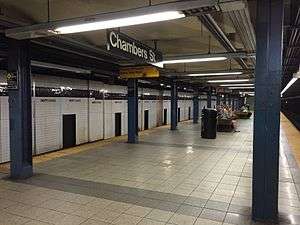 Express platform | |||||||||
| Station statistics | |||||||||
| Address |
Church Street between Chambers Street & Vesey Street New York, NY 10007 | ||||||||
| Borough | Manhattan | ||||||||
| Locale | Financial District | ||||||||
| Division | B (IND) | ||||||||
| Line | IND Eighth Avenue Line | ||||||||
| Services |
A C | ||||||||
| Platforms | 1 island platform | ||||||||
| Tracks | 2 | ||||||||
| Other information | |||||||||
| Opened | September 10, 1932[5] | ||||||||
| Station code | 170[1] | ||||||||
| Accessible |
| ||||||||
| Wireless service |
| ||||||||
| Station succession | |||||||||
| Next north |
Canal Street: A | ||||||||
| Next south |
Fulton Street: A | ||||||||
| |||||||||
Chambers Street, the express platform, is a through station. Just north of Chambers Street station is a third track between the uptown and downtown express tracks, with connecting switches at both ends, which was used to turn trains when Chambers Street was used as a terminal,[4] before the Broadway–Nassau Street (now Fulton Street) station opened on February 1, 1933.[7] It is served by the A and C trains. This platform is not wheelchair-accessible, although it can possibly gain accessibility in the future because the elevator to the local platform leads to the mezzanine that is shared with this station. However, it is one block away from the Chambers Street station on the IRT Broadway–Seventh Avenue Line, which is wheelchair-accessible.
World Trade Center
World Trade Center | |||||||
|---|---|---|---|---|---|---|---|
|
| |||||||
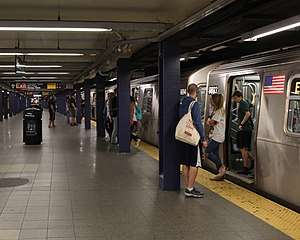 Local platform | |||||||
| Station statistics | |||||||
| Address |
Church Street between Chambers Street & Vesey Street New York, NY 10007 | ||||||
| Borough | Manhattan | ||||||
| Locale | Financial District | ||||||
| Division | B (IND) | ||||||
| Line | IND Eighth Avenue Line | ||||||
| Services |
E | ||||||
| Platforms | 1 island platform | ||||||
| Tracks | 2 | ||||||
| Other information | |||||||
| Opened | September 10, 1932[5] | ||||||
| Station code | 171[1] | ||||||
| Accessible |
| ||||||
| Wireless service |
| ||||||
| Former/other names | Hudson Terminal | ||||||
| Station succession | |||||||
| Next north |
Canal Street: E | ||||||
| Next south |
(Terminal): E | ||||||
|
| |||||||
| Next |
West Fourth Street–Washington Square: E | ||||||
| Next |
none: E | ||||||
| |||||||
World Trade Center, the local platform, forms the terminus of the local service and is offset to the south of the express platform, at the northern edge of the World Trade Center site.[4] It is served by the E train. Southbound local trains reach the platform by ramping underneath the express tracks south of Canal Street station. The northern end of the World Trade Center station has a signal tower and a diamond crossover switch that are roughly at the middle of the through-platform.
The local tracks end at bumper blocks at the south end of the platform. In addition, there is a platform-level passageway on the western side of the station toward the platform's south end, evidence of a former half-length side platform for the western track; while in passenger use as a connection to the rest of the station, the former platform is now fenced off from the rest of the local platform level, and passengers must now use the mezzanine to access the island platform.[8] A connection to the World Trade Center PATH station is also available at the station's south end;[9] this, in turn, gives access to the Fulton Center (via the Dey Street Passageway), the Cortlandt Street station of the BMT Broadway Line, and the World Trade Center–Cortlandt Street station on the IRT Broadway–Seventh Avenue Line.[10] Another passageway also leads directly to the southbound BMT Broadway Line platform.
The station was formerly named Hudson Terminal or H&M, after the nearby Hudson Terminal of the Hudson and Manhattan Railroad (now the PATH). Since 1973, this station has been named after the two World Trade Centers. Wall tiles reading "H AND M" remained on the walls of the World Trade Center station as late as December 1974,[11] a year after the first World Trade Center was completed. The tiles were initially painted over, but since the station's renovation, they have been covered over.
Accessibility
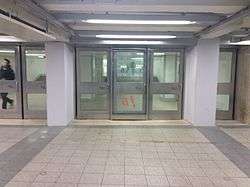
At the extreme southern end of the station is the exit to the Cortlandt Street station,[9][12] along with a few High Entrance-Exit Turnstiles (HEETs). Only this platform was ADA-accessible, and currently, only this platform is ADA-accessible. The doors and original ADA-accessible ramp, as well as the structure from the first World Trade Center leading into the station, survived the September 11 attacks.[12] The station itself was not damaged, but it was covered by dust and was subsequently closed.[13] The passageway reopened for a while to provide an ADA-connection from the New York City Subway station to the temporary World Trade Center PATH station, but was closed again when the temporary PATH station closed for a reconstruction.[13] The passageway was then covered in plywood for preservation purposes.[9]
The renovated entrance, leading from the New York City Subway station to the newly rebuilt PATH station's Oculus headhouse as well as to the Westfield World Trade Center, opened on December 19, 2016.[12][13] The newly reopened passageway retained its pre-9/11 design, save for a door on display that has the words "MATF 1 / 9 13" spray-painted on it (a message from Urban Search and Rescue Massachusetts Task Force 1 of Beverly, Massachusetts, who searched the World Trade Center site on September 13, 2001). There is a plaque above the spray-painting, explaining the message on the door.[9] PATH was required to preserve the passageway's original design as per Section 106 of the National Historic Preservation Act, as a condition for getting funding to construct the Oculus and new stations. The passageway was not be made ADA-accessible again until 2017, as there are twenty-six steps down from the mezzanine to the Oculus headhouse's lobby.[9] The World Trade Center platform is ADA accessible as of December 31, 2017, via this passageway as well as a side entrance to the Oculus headhouse.
The MTA's elevator to the local platform, at the southeast corner of Church Street and Park Place, connects to the local platform via a long ramp from the main mezzanine shared with Chambers Street, but it has been out of service from 2001 to 2017 due to long-term construction on the current World Trade Center. The elevator was planned to reopen in December 2017.[14]
Free transfer to Cortlandt Street
A free passageway at the southern end was planned as part of the Fulton Center project, which would have allowed for a free transfer between the local platform and the southbound Cortlandt Street station. However, a non-free transfer was to be made using the WTC Transportation Hub when the latter opened anyway, so it was presumed that the free transfer was then canceled.[15] As of June 2017, the connection was again slated to be built and the passageway opened with newly-rearranged turnstiles.[16][17] The connection opened on December 29, 2017 along with a passageway connecting World Trade Center with Tower 2, and passageways connecting the southbound platform of Cortlandt Street to the Oculus and to Tower 4. Fare control areas had to be reconfigured.[18]
Exits
Exits/entrances through turnstiles to Church Street are located in the mezzanine of this station, along with a few High Entrance-Exit Turnstiles (HEETs). There are street stairs:
- at all four corners of Church and Chambers Streets[19]
- at both western corners of Church and Warren Streets[19]
- at both western corners of Church and Murray Streets[19]
- at all four corners of Church Street and Park Place; there is also an elevator to the local platform at the southeastern corner[19]
- at the southwestern corner of Church and Barclay Streets[19]
- at the northwestern and southeastern corners of Church and Vesey Streets[19]
- at the northeastern corner of Church and Fulton Streets[19]
There is also a passageway to the PATH station at the very southern end of the local platform (described below).[9][12]
The only transfer between the local platform and the express platform is available only at the very tips of both platforms, where the two platforms are opposite each other for a few feet. Passengers must walk down the express platform to the southernmost staircase, go up to a different part of the mezzanine, crossover, and then go down a staircase to the northern end of the local platform. This complex transfer is to allow a continued underground mezzanine outside of fare control from the southern end at the World Trade Center, which is just one block west of the Fulton Street station on the IND Eighth Avenue Line, to the most northern street stairs at Chambers and Church Street, which is just one block east of the Chambers Street station of the IRT Broadway–Seventh Avenue Line.[19] The total length of the mezzanine is seven blocks.
Presentation on maps
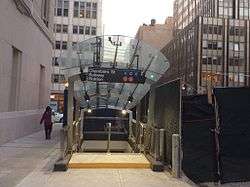
The station has been portrayed in a variety of ways on New York City Subway maps since 1932. Originally, it was shown as a single station called Chambers Street–Hudson Terminal. Starting in about 1948, two stations were shown, Chambers Street–Hudson Terminal for the express trains continuing to Brooklyn, and Hudson Terminal for the local trains terminating at the station. A 1959 map showed two stations enclosed in a box, but a single label. The 1964 and 1966 maps were similar.
On the 1972 map, it once again appeared to be a single station, with the label showing Chambers Street, Hudson Terminal, World Trade Center, and PATH, although the Hudson Terminal office building complex had already been demolished by this time.
On the current map[20] published by the Metropolitan Transportation Authority, it is shown as two separate stations with a free transfer—Chambers Street (served by A and C trains) and World Trade Center (served by E trains). Signs in the Fulton Center only show the E when pointing toward the World Trade Center station, as the A, C, 2 and 3 trains serve both station complexes.
January 23, 2005 fire
Around 2:00 p.m. on January 23, 2005, a fire destroyed the interlocking plant at Chambers Street. As a result, two-thirds of A trains were canceled or rerouted, including all rush-hour trips to Rockaway Park–Beach 116th Street. C service was completely suspended and replaced by the A and V in Brooklyn and A, B, D, and E in Manhattan. Some newspaper articles blamed the fire on a homeless person trying to keep warm, but that was never confirmed.[21] Until January 28, the MTA rerouted the A to the connected IND Sixth Avenue Line, Rutgers Street Tunnel, and IND Culver Line (the route used by regular F service) from West Fourth Street to Jay Street between 10 p.m. and 5 a.m., in order to perform critical repairs.
Initial estimates gave a time of three to five years to restore full service because the destroyed equipment was custom-made for the MTA.[22] That was later cut back to six to nine months to bring back normal operations. However, C service and 70% of A service was restored at 5 a.m. on February 2, 2005, only ten days after the fire. The rush-hour A trips were restored on February 14. On April 21, full service was restored. However, effects of the fire continued into 2006 because the equipment had not been replaced.[22]
IRT Broadway–Seventh Avenue Line platform
Park Place | |||||||||||||
|---|---|---|---|---|---|---|---|---|---|---|---|---|---|
|
| |||||||||||||
|
| |||||||||||||
| Station statistics | |||||||||||||
| Address |
Park Place & Broadway New York, NY 10007 | ||||||||||||
| Borough | Manhattan | ||||||||||||
| Locale | Financial District | ||||||||||||
| Division | A (IRT) | ||||||||||||
| Line | IRT Broadway–Seventh Avenue Line | ||||||||||||
| Services |
2 3 | ||||||||||||
| Platforms | 1 island platform | ||||||||||||
| Tracks | 2 | ||||||||||||
| Other information | |||||||||||||
| Opened | July 1, 1918 | ||||||||||||
| Station code | 331[1] | ||||||||||||
| Accessible |
| ||||||||||||
| Wireless service |
| ||||||||||||
| Station succession | |||||||||||||
| Next north |
Chambers Street: 2 | ||||||||||||
| Next south |
Fulton Street: 2 | ||||||||||||
| |||||||||||||
The Park Place station on the IRT Broadway–Seventh Avenue Line was built on the portion of the line built as part of the Dual Contracts, which is the section south of Times Square–42nd Street. The line first opened as a shuttle to 34th Street–Penn Station on June 3, 1917,[23][24] and then south to South Ferry on July 1, 1918. On this same date, the Fulton Street station opened, with service to the station running as a shuttle between Chambers Street and Wall Street, on the line's Brooklyn Branch.[25] On August 1, 1918, the new "H" system was implemented on August 1, 1918, joining the two halves of the Broadway–Seventh Avenue Line and sending all West Side trains south from Times Square.[26] As a result, shuttle service to this station was replaced by through service.[27]
During the 1964–1965 fiscal year, the platforms at Park Place, along with those at four other stations on the Broadway–Seventh Avenue Line, were lengthened to 525 feet to accommodate a ten-car train of 51-foot IRT cars.[28]
It has two tracks and a single island platform with a line of blue i-beam columns with alternating ones having the standard black name plate in white lettering. Both track walls have a mostly gold trim line along with the "P" tablets at regular intervals.
Northwest (railroad north) of the station, the tracks of this station become the express tracks of the IRT Broadway–Seventh Avenue Line, curving sharply northeast under West Broadway.[4] The station is very close to the next stop north, Chambers Street at West Broadway, and the northernmost entrances of this station at Church and Chambers Streets are less than 400 feet (120 m) from the entrances to the station at Chambers Street and West Broadway.[19]
Exits
The station has a mezzanine at each end. Towards the western end of the platform, two long staircases lead up to an intermediate landing where another, shorter staircase leads up to the main IND mezzanine near the full Oculus mosaic. From here, there is a bank of turnstiles leading to the street stair that goes to the northwest corner of Park Place and Church Street. A staircase in this mezzanine leads down to the very southern end of the IND express platform, where transfer to the local platform is via another set of stairs.[19]
The IRT platform has its own entrance/exit at its extreme eastern (railroad south) end. Here, a staircase and two escalators, none of which are together, lead up to a mezzanine just beneath the street. The staircase splits into two separate staircases at an initial landing and each of those have another intermediate landing. On this mezzanine, there are turnstiles, both regular and HEET (from when the mezzanine had a part-time token booth and the regular turnstiles could not be left unstaffed). A single street stair leads out to the northwest corner of Broadway and Park Place. The signage for this entrance is the only one in the complex that says "Park Place" with bullets only for the 2 and 3 trains. This stair is very close to the BMT Broadway Line's City Hall station, an entrance to which is about 200 feet (61 m) away, on the other side of Broadway.[19] A short staircase in that mezzanine once led to an entrance to the lobby of the Woolworth Building. It has been closed since the September 11 attacks.
- Track wall mosaic
 Entrance at Park Place & Broadway
Entrance at Park Place & Broadway
Oculus mosaics
There are over 300 mosaics dispersed throughout the station, which are part of the 1998 installation Oculus created by Kristin Jones and Andrew Ginzel. These eyes were modeled on photographs of the eyes of hundreds of New Yorkers.[29]
According to Jones and Ginzel,
Oculus is a constellation of stone and glass mosaics in the underground labyrinth of interconnected subway stations of lower Manhattan. Over three hundred mosaic eyes, drawn from a photographic study of more than twelve hundred young New Yorkers, are set into the white tile walls of the World Trade Center/Park Place/Chamber Street Stations. The work's centerpiece is a large exquisitely detailed, elliptical glass and stone mosaic floor (38 ft 8 in x 20'8") at the heart of the Park Place Station. The continents of the earth, interwoven with the City of New York amidst an ultramarine pool, surround a large eye in the middle of the mosaic. The mosaic is at once a vision of the world, a reflecting pool of water and a representation New York City in its proper geographical orientation.
The eyes of "Oculus"The work's detailed renderings of the eye–the most telling, fragile and vulnerable human feature–offer a profound sense of intimacy within a public place. Together, the images create a sense of unity and flow: animating, orienting and humanizing the station. Oculus invites a dialogue between the site and those who move through it.
The former World Trade Center Station is situated at the northeast corner of the site. The station was flooded and closed to the public following the September 11, 2001 attack. The site was damaged but not destroyed, and it reopened eight months later with the work mostly intact. Oculus was recognized as "an unexpected monument" by The Wall Street Journal on September 11, 2003.
Oculus was realized in collaboration with the Roman mosaicist, Rinaldo Piras, Sectile.[30]
Nearby points of interest
- Brookfield Place (formerly World Financial Center)[19]
- Battery Park City[19]
- Century 21 (also near the adjacent Fulton Street station)[19]
- Church Street Post Office[19]
- New York Public Library New Amsterdam Branch[19]
- Saks Fifth Avenue Downtown division[19]
- St. Paul's Chapel[19]
- Trinity Church[19]
- Woolworth Building[19]
- World Trade Center buildings (see also World Trade Center site)[19]
References
- 1 2 3 4 "Station Developers' Information". Metropolitan Transportation Authority. Retrieved June 13, 2017.
- 1 2 3 4 "NYC Subway Wireless – Active Stations". Transit Wireless Wifi. Retrieved May 18, 2016.
- ↑ "Facts and Figures: Annual Subway Ridership 2012–2017". Metropolitan Transportation Authority. July 12, 2018. Retrieved July 12, 2018.
- 1 2 3 4 Dougherty, Peter (2006) [2002]. Tracks of the New York City Subway 2006 (3rd ed.). Dougherty. OCLC 49777633 – via Google Books.
- 1 2 3 New York Times, List of the 28 Stations on the New Eighth Ave Line, September 10, 1932, page 6
- ↑ Crowell, Paul (September 10, 1932). "Gay Midnight Crowd Rides First Trains In The New Subway: Throngs at Station an Hour Before Time, Rush Turnstiles When Chains are Dropped" (PDF). New York Times. Retrieved November 8, 2015.
- ↑ "City Opens Subway to Brooklyn Today". New York Times. February 1, 1933. p. 19.
- ↑ Photo of side platform in use, dated September 1, 1990
- 1 2 3 4 5 6 Dunlap, David W. (December 18, 2016). "A Vestige of the Original World Trade Center Returns to Duty". The New York Times. Retrieved December 19, 2016.
- ↑ Yee, Vivian (November 9, 2014). "Out of Dust and Debris, a New Jewel Rises". New York Times.
- ↑ NYCSubway.org: Photograph of H&M/World Trade Center station dated December 12, 1974
- 1 2 3 4
- Higgs, Larry (December 13, 2016). "When will the E Train be connected to WTC hub?". NJ.com. Retrieved December 16, 2016.
- "WTC Oculus E train access opens Monday". am New York. December 18, 2016. Retrieved December 19, 2016.
- 1 2 3 Tirella, Talia (December 18, 2016). "Long-closed passageway from original WTC to reopen on Monday". New York's PIX11 / WPIX-TV. Retrieved December 19, 2016.
- ↑ "Transit and Bus Committee February 2017" (PDF). mta.info. Metropolitan Transportation Authority. February 21, 2017. Retrieved February 21, 2017.
- ↑ Yee, Vivian (November 9, 2014). "Out of Dust and Debris, a New Jewel Rises". The New York Times.
- ↑ "Update on the Cortlandt Street Subway Station". Tribeca Citizen. June 15, 2017. Retrieved June 16, 2017.
- ↑ "T6041409 Reserve: Church Street Corridor Improvements Passenger Stations". web.mta.info. Metropolitan Transportation Authority. Retrieved September 3, 2017.
- ↑ "Getting to the Oculus Just Got Much Easier". Tribeca Citizen. December 30, 2017. Retrieved January 3, 2018.
- 1 2 3 4 5 6 7 8 9 10 11 12 13 14 15 16 17 18 19 20 21 "MTA Neighborhood Maps: Lower Manhattan" (PDF). mta.info. Metropolitan Transportation Authority. 2015. Retrieved August 16, 2016.
- ↑ "Subway Map" (PDF). Metropolitan Transportation Authority. January 18, 2018. Retrieved January 18, 2018.
- ↑ "Signal Room Fire Reroutes Trains on 3 Subway Lines". The New York Times. January 24, 2005. Retrieved July 6, 2016.
- 1 2 Chan, Sewell (January 25, 2006). "Year After Subway Fire, Damaged Equipment Is Still Not Replaced". The New York Times. Retrieved October 27, 2015.
- ↑ "Three New Links of the Dual Subway System Opened, Including a Shuttle Service from Times Square to Thirty-Fourth Street — Service on the Jerome Avenue Branch From 149th Street North to About 225th Street Began Yesterday Afternoon — The Event Celebrated by Bronx Citizens and Property Owners — The Seventh Avenue Connection Opened This Morning" (PDF). The New York Times. June 3, 1917. p. 1. Retrieved November 6, 2016.
- ↑ "Annual report. 1916-1917". HathiTrust. Interborough Rapid Transit Company. December 12, 2013. p. 22. Retrieved September 5, 2016.
- ↑ "Open New Subway to Regular Traffic — First Train on Seventh Avenue Line Carries Mayor and Other Officials — To Serve Lower West Side — Whitney Predicts an Awakening of the District — New Extensions of Elevated Railroad Service" (PDF). The New York Times. July 2, 1918. p. 11. Retrieved November 6, 2016.
- ↑ "Open New Subway Lines to Traffic; Called a Triumph — Great H System Put in Operation Marks an Era in Railroad Construction — No Hitch in the Plans — But Public Gropes Blindly to Find the Way in Maze of New Stations — Thousands Go Astray — Leaders in City's Life Hail Accomplishment of Great Task at Meeting at the Astor" (PDF). The New York Times. August 2, 1918. p. 1. Retrieved November 6, 2016.
- ↑ Whitney, Travis H. (March 10, 1918). "The Seventh and Lexington Avenue Subways Will Revive Dormant Sections — Change in Operation That Will Transform Original Four-Tracked Subway Into Two Four-Tracked Systems and Double Present Capacity of the Interborough" (PDF). The New York Times. p. 12. Retrieved August 26, 2016.
- ↑ Annual Report 1964–1965. New York City Transit Authority. 1965.
- ↑ "www.nycsubway.org: IND 8th Avenue Line". www.nycsubway.org. Retrieved July 4, 2016.
- ↑ Jones, Kristin; Ginzel, Andrew, Oculus, retrieved June 4, 2012
External links
| Wikimedia Commons has media related to Chambers Street – World Trade Center / Park Place (New York City Subway). |
NYC Subway.org:
- nycsubway.org – IRT West Side Line: Park Place
- nycsubway.org – IND 8th Avenue: Chambers Street/World Trade Center
- nycsubway.org – New York City Subway Historical Maps:
- nycsubway.org – Oculus Artwork by Jones and Ginzel (1998)
Miscellaneous:
- Station Reporter – World Trade Center Complex
- The Subway Nut – Chambers Street–Park Place–World Trade Center (A, C, E)
- The Subway Nut – Park Place (2, 3)
- A/C/V service updates after the fire (Internet Archive)
- MTA's Arts For Transit – Chambers Street/Park Place
Google Maps: Street View:
- Chambers Street entrance from Google Maps Street View
- Warren Street entrance from Google Maps Street View
- Murray Street entrance from Google Maps Street View
- Park Place and Church Street entrance from Google Maps Street View
- Barclay Street entrance from Google Maps Street View
- Vesey Street entrance from Google Maps Street View
- Park Place and Broadway entrance from Google Maps Street View
- IND local platform from Google Maps Street View
- IND express platform from Google Maps Street View
- IRT platform from Google Maps Street View




